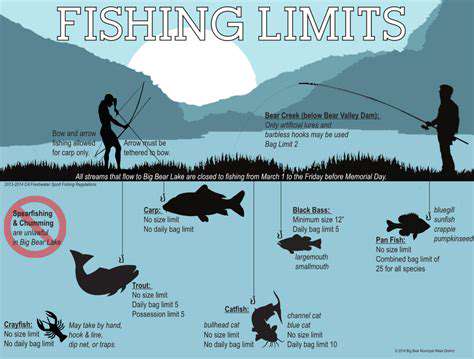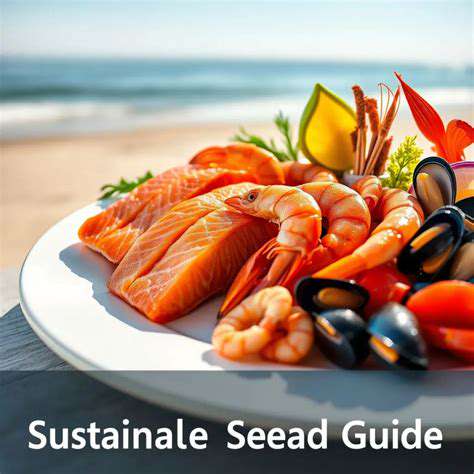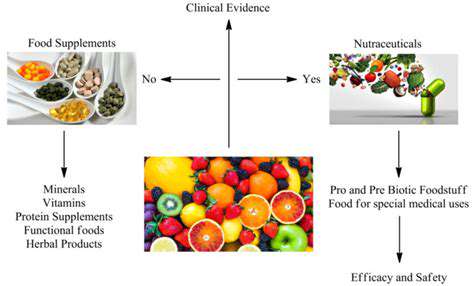Minimizing Bycatch and Protecting Marine Ecosystems
Minimizing Bycatch in Fishing Practices
Bycatch, the unintentional capture of non-target marine species during fishing operations, poses a significant threat to marine ecosystems. It's not just about the sheer numbers of fish or other creatures caught; bycatch also includes crucial species at various life stages, impacting their populations and the delicate balance of the food web. This unintended capture can include juvenile fish, sea turtles, marine mammals, and seabirds, disrupting natural reproduction cycles and potentially leading to the decline of entire species. Understanding and mitigating bycatch is crucial for maintaining healthy and thriving marine ecosystems.
Implementing selective fishing gear and techniques is vital. This includes the development and use of gear that targets specific species while minimizing the capture of non-target organisms. Furthermore, modifying fishing practices, such as adjusting fishing times or locations, can help reduce bycatch. Stricter regulations and enforcement are necessary to ensure compliance with these practices. The long-term sustainability of our oceans depends on our commitment to reducing bycatch and protecting the biodiversity within them.
Protecting Vulnerable Marine Species
Certain marine species are particularly vulnerable to bycatch and habitat destruction due to their life stages, behaviour, or physical characteristics. Protecting these species is essential for the overall health of marine ecosystems. Understanding the migratory patterns, breeding grounds, and feeding habits of these species is crucial for developing effective conservation strategies. Many species, particularly seabirds and turtles, often become entangled in fishing gear, suffering injuries or drowning. This underscores the urgent need for innovative solutions and more stringent regulations.
Protecting their habitats is just as important as preventing bycatch. Marine protected areas (MPAs) can safeguard critical habitats and allow vulnerable populations to thrive. These areas, carefully managed, can provide safe havens for breeding and feeding, contributing to the recovery of populations impacted by bycatch and other human activities. Collaboration between governments, fisheries, and conservation organizations is vital for the effective implementation of these strategies.
Sustainable Fishing Practices for Long-Term Viability
Sustainable fishing practices are not only crucial for minimizing bycatch but also for ensuring the long-term health and productivity of fish stocks. Overfishing, a significant driver of ecosystem decline, can drastically reduce the populations of many commercially important species and disrupt the intricate food webs upon which they depend. Adopting sustainable fishing practices that maintain healthy fish populations is paramount for maintaining the long-term viability of the industry and the ecosystems it impacts. This includes implementing catch limits, size restrictions, and seasonal closures to allow fish populations to recover and replenish.
Investing in research and development of new fishing technologies and techniques that minimize bycatch is also essential. This includes the development of more selective fishing gear, the use of acoustic deterrents, and the implementation of fishing strategies that prioritize the protection of vulnerable species. By prioritizing sustainability, we can ensure that future generations can continue to benefit from the resources of our oceans.
The Role of Consumer Awareness in Promoting Sustainable Seafood
Consumer awareness plays a significant role in driving the demand for sustainably caught seafood. By making informed choices about the seafood they consume, consumers can support sustainable fishing practices and help reduce the impact of bycatch on marine ecosystems. Knowing the origin and sourcing of seafood is crucial. Consumers should look for labels and certifications that guarantee sustainable fishing practices and minimize bycatch. Supporting businesses committed to sustainable seafood practices is another important step.
Educating consumers about the environmental impacts of various fishing methods and the importance of bycatch reduction is essential. Promoting responsible seafood consumption habits and advocating for policies that support sustainable fisheries can significantly impact the industry and protect marine ecosystems. Ultimately, consumer demand for sustainable seafood is a powerful tool in driving change and promoting the long-term health of our oceans.
Implementing Effective Fishing Gear and Catch Limits

Choosing the Right Fishing Rod
Selecting the appropriate fishing rod is paramount to a successful fishing trip. Consider the type of fish you intend to target and the fishing environment. A lightweight rod is ideal for delicate lures and smaller fish, while a heavier rod is better suited for larger fish and stronger currents. The length of the rod also plays a crucial role, affecting casting distance and maneuverability. A longer rod typically offers greater casting distance, but can be less maneuverable in tight spaces. Understanding these factors will help you select a rod that meets your specific needs and ensures a comfortable and effective fishing experience.
Different fishing rods are designed for various fishing styles and environments. A fast-action rod, for example, is known for its responsiveness and power, making it excellent for casting lures and fighting larger fish. A moderate-action rod offers a balance of sensitivity and power, suitable for a wider range of fishing techniques. Understanding these nuances will guide your decision in selecting the right rod, enhancing your overall fishing experience.
Selecting the Perfect Fishing Line
Fishing line is a critical component of any fishing setup, directly impacting your ability to cast effectively and catch fish. The type of line you choose should match the size and species of fish you are targeting. Stronger lines are essential when dealing with larger fish to prevent breakage during the fight. Heavier lines are typically necessary in rough waters or when targeting stronger fish, while lighter lines are better suited for smaller fish and delicate lures.
Line diameter and strength are key considerations. A thinner line may cast further but may not withstand the strain of a larger fish, thus increasing the risk of breakage. Conversely, a thicker line, while offering greater strength, can reduce casting distance. Finding the right balance between these factors will optimize your fishing experience.
Essential Fishing Tackle for Success
Beyond the rod and line, a variety of essential tackle complements your fishing gear. Lures, hooks, and sinkers are fundamental tools that can significantly enhance your fishing success. The type of lure you use should align with the species of fish you are targeting. For example, spinnerbaits are effective for attracting bass, while jigs are useful for targeting various fish species.
The proper choice of hooks and sinkers is also vital. Hooks need to be strong enough to hold the fish without breaking, while sinkers help to keep the lure submerged at the desired depth. Furthermore, a well-stocked tackle box includes various sizes and styles of hooks and sinkers, catering to different fishing situations and environments.
Maintaining and Caring for Your Fishing Gear
Proper maintenance of your fishing gear is crucial for its longevity and optimal performance. Regularly cleaning your rods, reels, and lines is essential to prevent damage and maintain their functionality. Rinse off any debris and saltwater immediately after use to prevent corrosion and maintain the integrity of your equipment. This proactive care extends the lifespan of your gear, ensuring a smoother and more successful fishing experience.
Storing your fishing gear correctly is also important. Protecting it from moisture and extreme temperatures will maintain its condition. Proper storage will prevent damage caused by prolonged exposure to the elements, ensuring that your fishing gear is ready to use whenever you are.
Data cleaning is a crucial initial step in any data analysis project. It involves identifying and correcting or removing inaccurate, incomplete, or inconsistent data points. This process ensures that the data is reliable and suitable for further analysis. Cleaning techniques often include handling missing values, correcting errors, and standardizing formats. Thorough data cleaning can significantly impact the quality and accuracy of results.

Enhancing Fisheries Management and Monitoring
Improving Data Collection and Analysis
Robust fisheries management hinges on accurate and comprehensive data. This involves implementing standardized methods for collecting data on fish populations, including their size, age, and reproductive status. Advanced technologies such as acoustic surveys and electronic tagging can significantly enhance the accuracy and efficiency of data collection, providing a more complete picture of fish stocks. Furthermore, sophisticated analytical tools are essential for processing and interpreting this data, enabling scientists to identify trends and patterns that might otherwise be missed, ultimately leading to more informed management decisions.
Effective data analysis is crucial for identifying potential threats to fish populations and predicting future trends. This analysis should consider environmental factors like water temperature, salinity, and ocean currents, as well as human pressures such as fishing practices and pollution. By linking these various data points, researchers can develop a clearer understanding of the complex interactions shaping fish populations and predict how these populations might respond to different management strategies.
Implementing Sustainable Fishing Practices
Sustainable fishing practices are paramount to the long-term health of fish populations and the overall marine ecosystem. This includes establishing catch limits and size restrictions to ensure that only mature fish are harvested, minimizing bycatch, and employing fishing gear that reduces damage to habitats. Properly regulated fishing quotas, coupled with enforcement mechanisms, are vital to prevent overfishing and ensure the sustainability of fish stocks for future generations.
Strengthening Marine Protected Areas
Establishing and effectively managing marine protected areas (MPAs) can play a critical role in safeguarding fish populations and promoting biodiversity. These areas provide crucial habitats for fish to reproduce, grow, and seek refuge from fishing pressure. Careful planning and zoning within MPAs are essential to ensure that these areas effectively support the recovery and maintenance of healthy fish populations, while also accommodating other human activities in a sustainable manner.
Enhancing Monitoring and Enforcement
Effective fisheries management requires robust monitoring and enforcement mechanisms. This includes the use of advanced technologies like satellite tagging and remote sensing to track fishing vessels and monitor fishing activity. Stronger international cooperation and collaboration between nations on issues related to illegal, unreported, and unregulated (IUU) fishing is crucial to combating these practices and promoting ethical and sustainable fishing practices globally. This involves improved communication and information sharing, as well as the development of coordinated enforcement strategies.
Promoting Community Engagement and Education
Engaging local communities and promoting public awareness about sustainable fisheries management is vital for achieving long-term success. Involving fishermen, coastal communities, and other stakeholders in decision-making processes can foster a sense of ownership and responsibility for the health of marine resources. Education programs can play a critical role in raising awareness about the importance of sustainable fishing practices and the interconnectedness of marine ecosystems. Effective communication strategies and transparent decision-making processes are critical to ensure broad community support for sustainable fisheries management goals.










